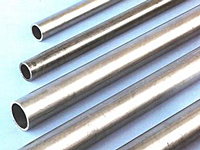| Items |

6061-T6SP80-100-179
Seamless Aluminum Pipe - Series 6061-T6 Schedule 80
|

6061-T6SP80-1250-191
Seamless Aluminum Pipe - Series 6061-T6 Schedule 80
|

6061-T6SP80-1500-200
Seamless Aluminum Pipe - Series 6061-T6 Schedule 80
|

6061-T6SP80-200-218
Seamless Aluminum Pipe - Series 6061-T6 Schedule 80
|

6061-T6SP80-250-376
Seamless Aluminum Pipe - Series 6061-T6 Schedule 80
|
|
Material
|
N/A
Aluminum
|
|
Shapeform
|
N/A
Pipe
|
|
Series
|
N/A
6061-T6
|
|
Grade
|
N/A
6061
|
|
Temper
|
N/A
T6
|
|
Standard
|
N/A
Schedule 80
|
|
Nominal Size
|
N/A
1 inches
|
N/A
1 1/4 inches
|
N/A
1 1/2 inches
|
N/A
2 inches
|
N/A
2 1/2 inches
|
|
Nominal Size
|
N/A
1 inches25.4 mm
|
N/A
1.25 inches31.75 mm
|
N/A
1.5 inches38.1 mm
|
N/A
2 inches50.8 mm
|
N/A
2.5 inches63.5 mm
|
|
O.D.
|
N/A
1.315 inches33.401 mm
|
N/A
1.66 inches42.164 mm
|
N/A
1.9 inches48.26 mm
|
N/A
2.375 inches60.325 mm
|
N/A
2.875 inches73.025 mm
|
|
I.D.
|
N/A
0.957 inches24.3078 mm
|
N/A
1.278 inches32.4612 mm
|
N/A
1.500 inches38.1 mm
|
N/A
1.939 inches49.2506 mm
|
N/A
1.323 inches33.6042 mm
|
|
Wall Thickness
|
N/A
0.179 inches4.5466 mm
|
N/A
0.191 inches4.8514 mm
|
N/A
0.200 inches5.08 mm
|
N/A
0.218 inches5.5372 mm
|
N/A
0.376 inches9.5504 mm
|
|
Weight
|
N/A
0.7513 lbs/ft1.1180576132 kg/m
|
N/A
1.0366 lbs/ft1.5426308024 kg/m
|
N/A
1.2561 lbs/ft1.8692828004 kg/m
|
N/A
1.7373 lbs/ft2.5853873172 kg/m
|
N/A
6.0177 lbs/ft8.9553245028 kg/m
|
|
Weight per 20'
|
N/A
15.025 lbs6.81534 kg
|
N/A
20.732 lbs9.4040352 kg
|
N/A
25.123 lbs11.3957928 kg
|
N/A
34.745 lbs15.760332 kg
|
N/A
120.355 lbs54.593028 kg
|
|
ASTM Specification
|
N/A
ASME S241M ASME SB241 ASTM B241 Mil-P-25995 UNS A96061
|
|
Length
|
N/A
20 ft
|
|
Ultimate Strength
|
N/A
45 ksi
|
|
Yield Strength
|
N/A
40 ksi
|
|
Elongation percent in 2 inches
|
N/A
12
|
|
Hardness Brinnel Number
|
N/A
95
|
|
Ultimate Shearing Strength
|
N/A
30 ksi
|
|
Fatigue Endurance Limit1
|
N/A
14 ksi
|
|
Modulus of Elasticity2
|
N/A
10.0 x 103 ksi
|
|
Resistance to Corrosion - General3
|
N/A
B
|
|
Stress Corrosion Cracking
|
N/A
A
|
|
Workability (Cold)
|
N/A
C
|
|
Mechinability
|
N/A
C
|
|
Brazeability4
|
N/A
A
|
|
Gas Weldability5
|
N/A
A
|
|
Arc Weldability6
|
N/A
A
|
|
Resistance Spot and Seam Weldability7
|
N/A
A
|
|
Applications
|
N/A
Heavy-duty structures requiring good corrosion resistance, truck and marine, railroad cars, furniture, pipelines
|
|
Density
|
N/A
0.098 lbs/in³
|
|
Specific Gravity
|
N/A
2.70
|


